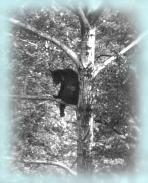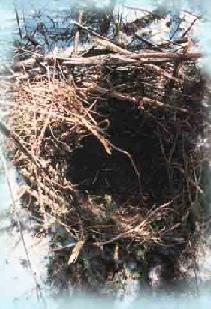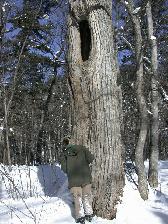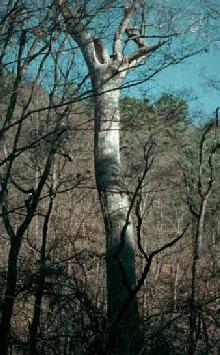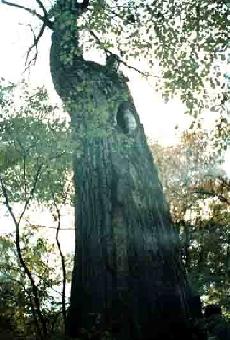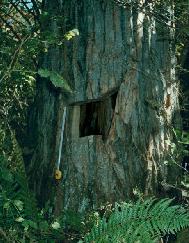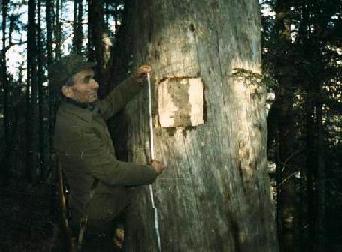|
THE ASIAN BLACK BEAR OF PRIMORYE* By Alexey Zborovskiy |
|
|
|
* Translated from Russian by both the World Society for the Protection of Animals - volunteer Caroline Yates and the author. Photos, if not signed, by author. |
||
|
Photo 1. By Roman Anosov |
|
PART 1.
Key aspects of the species biology in
Primorye
Names
The scientific name
for the species in

Peculiarities
of the outer appearance of the Himalayan bear
Thick black fur grows
round the neck like a mane, the face is somewhat elongated with rounded ears
positioned high up on the head (photos 1, 2), massive shoulders. All this, plus
a noticeable white mark on the chest (reminiscent of a seagull in flight, or a
young moon) compose the portrait of our hero.
Most Himalayan bears
have black paws, some wear white “gloves” and/or
“socks”, few even own white claws!

Photo 1 - The
Hymalayan bear.
By Alexei Bezrookov
([email protected])
Nature’s
competitors
The Himalayan bear is
rather a large vegetarian, than large predator. For this reason, he is hunted
not only by Man, but tigers and even brown bears (last particularly often
attack during the period when food is scarce). When in danger, the Himalayan
bear scrambles up a tree, where he can sit it out for days (photo 1). Neither a
tiger nor a brown bear is capable of scrambling up the thick trunk of a tree
devoid of any branches. The Himalayan bear can do this thanks to his light
weight and short sharp nails.
Most Himalayan bears
would run away when meeting people. Female, accompanied by her cubs, may charge
a human. Such attacks, as rule, result in spooking or several wounding of a
__________________________________________________________________________________
**
The solution would be to follow few simple rules when visiting bear forests
these days: 1) wear a bear-spooking (not a bear-killing one!) -weapon; 2) don't
approach bear cubs; 3) avoid places of high concentration of crows (last can be
detected distantly by croaks). Crows are usually point on the presence of
either bear or tiger on a kill. The one, who acts like another crow – i.
e. disturbes our brothers while they eat, falls into a grate risk!
Feed
Through spring-summer
season the Himalayan bear feeds mainly on juicy greens and a ration of small
animals – particularly insects. The nutritious cedar (Korean pine)
-nuts and the Mongolian oak acornss, rripening just before the period of
winter food shortages sets in, allow ABBs to store up enough body fat for the hibernation
period. In the years of poore naturally growing, fat-providing food in the
wild, bears will make trips to cultivated land, where crops are growing. Such
years are characterized by increase of bear damage to the forest beeyards and
cabins as well.
Mating
The mating season is
from the end of May to late July. To this time period relates the phenomenon
known as the “bear weddings” - when single females are sometimes
accompanied by more than just one male. Beware meet such escorts in our bushes!
Shelter
& rearing of young
Similarly to his
brown relative (e. g. Ursus arctos), the hero of our review spends
winter season in shelter. There is too few food accessible and to high
possibility of being snow-tracked by enemies at this period of the annual life
cycle. In the den ABB female brings up her youngs.
Potentially,
Himalayan bears can sleep, spend winter and even give birth to their cubs
anywhere: at the base of a large tree, in niches in cliffs, different hollows
in the earth. They even make constructions of twigs and branches like bird
nests, but built directly on the ground (photo 3). It is an obvious fact,
however, that the better surroundings, in which the animal meets its natural
requirements, the grater are it's both comfort and happiness!
Now you can easily
understand why does the Himalayan bear prefer make his lair inside of the
strong hollow poplar or lime tree or similar. A good lair of this type can be
very safe. Such a one should have a decent enough sized cavity, sturdy walls
(which cannot be pulled down by tigers or brown bears), as well as an entry
opening inaccessible to unwanted guests (photos 4-6, drawing 1). Last is called
“CHE-LO” in Russian. An ideal one chelo should be not less than 4
meters off the ground.
|
|
|
|
Photos 3, 4. The Himalyan bear "nest" and the normal tree den. Both photos by Linda Kerley. |
|
Sometimes the process
of transforming a tree into a lair takes more than a century. For a tree has to
reach the right height and maturity, as well as to go through the rotting away
process of the inside of the trunk.
How the bear chooses
one or other type of shelter for winter hibernation depends on a number of
factors such as the proximity of places for concern (e.g. human habitats) and
the bear’s own characteristics: nutritional state, body size, sex,
pregnancy etc. Himalayan bear males care of their future by letting females use
the best remaining winter tree-dens.
|
|
|
|
|
Photo 5
– The most beautiful tree-lair ever seen by author. The |
Photo 6
- The
largest tree-lair ever visited by author (was shown to last by Dr. V. S.
Khramtsov - the former director of |
Drawing 1. |
In January and
February females of the Himalayan bear bring up their progeny. Inside of the
lairs tiny bear-cubs appear – the size of a month old kitten. As is well
known, a cottage built of wood is warmer than one built of stone. The same is
for the bear-cubs: a wooden “maternity unit” is much warmer than
niches in cliffs and even more so than something in “nest”***.
A
bear-cub requires more than a year under the tuition of his mother to learn
everything about finding food and avoiding danger etc. This explains why in a
lair with the female adult bear, it is not unusual to find not only new-born
cubs, but even young bears of over 1 year old. These young bears are also known
as “mentors”, as they too participate in the rearing of their
younger brothers and sisters.
__________________________________________________________________________________
***
Such ground
“nests” indicate that the local bear population is in trouble.
Himalayan bears, hibernating in such nests, are frequently killed by tigers and
brown bears. But even if not: just imagine yourself in winter sleeping out in a
sleepingbag under an open sky! By the way, winter rains are not unusual in
Primorye's southern districts. Even pregnant female bears are sometimes found
hibernating on the ground now.
Best Himalayan bear habitat in Russia
Today’s
best Himalayan bear habitat in
|
|
Photo 7 - Pine/broad-leafed forest – the ideal habitat for the Himalayan bear. By Alexei Bezrookov ([email protected]) |
PART 2.
The use and protection of the Himalayan
bears in
Use of bear habitat by people
On
one hand, there is a growing demand for both the Primorye's timber and pine
nuts, and, on the other one - people utilize these resources by very rough
methods.The result is increasing suffering of not only bears, but of almost all
other taiga's animals. A non-sustained logging causes the greatest damage. In
addition to cutting off the largest trees, felling companies make hundreds new
roads through taiga every year. Most people, who come in by these roads, are
looking for remaining trees, for animals, or for other forest resources (such
as pine nuts etc.). As if there was such a rule, while taking things from
Mother Nature, they give back nothing. They neither plant trees, nor feed or
cure any animals. All they leave after their visits are stumps, garbage, and
the animal's blood. The one of the most magnicificant landscapes on the Earth
– unique Primorye's taiga - is being destroyed by those whom she feeds.
The Mother Nature is in fact nothing other than manifestation of God –
the One, Who supports every single breath of us.
Local bear hunting
Hunting brown bears
can sometimes be very dangerous, but this is rarely true for the Himalayan
ones. One needs neither much bravery nor masterity to kill a frightened bear
hiding up in a tree (photo 1). Same with bears that hide themselves in a hollow
trees in winter times. While out hunting, hunters cause additional harm to the
ABB population by damaging the rarely available wooden “maternity
units” (photos 8, 9). Unfortunately, the violence is still practiced in
the contemporary world.
|
|
Photo 8. This Himalayan bear den was damaged about 10 years back – by an axe. Without restoration it wouldn't serve any bear anymore. The photo was taken in Lazo district of Primorye – the area, rented by the state game agency “Lazovskoye”, fall 2001. |
|
Photo 9. This potential den was destroyed just recently – by the motorsaw. The same area. |
Many Himalayan bears are being shot at the forest beeyards,
where they come in search for food – the bee-pups and the honey (see paseka_engl.html).
This way died most of the annually killed moonbears of Primorye just about 1-2
decades ago. Even today, this type of hunting seriously influences species
population in
Cubs
and adult bear parts illegal trade
Since early 1990-s,
trade with bear paws and gallbludders, sometimes together with sale of live
cubs, formed a new “department” of the Russian-Chinese black
market. This has happened due to both the people’s ignorance
(superstitious beliefs and the like) and egoism. For example, in accordance
with a popular tail, a bear paw soup helps in one’s business. Such
rediculous beliefs along with Man's craving for more and more resulted in
recent disappearance of wild bears from majority of the óhinese forests. (To
The bear bile is
indeed helpful against some diseases. But most of the ills and weaks we obtain
through our own wrong conducts, such as harmful habits etc., don't we? Why
should animals pay with their lifes and happiness for our own mistakes? Anyway
- to cure the disease one must cure the ccausse, not the affect, as it commonly
done! Simple preventive measures, like eating healthy food at proper times and
in amount which is just enough, avoiding unnessesary waste of both physical and
menthal energies, avoiding intoxicants etc. would protect us from many of
deseases, including those, which are cured by bear bile. The benefit from the
right livelihood is a long-term – e. g. a stable one health. Only the
short-term “health” can be obtained by applying bear bile to the
affect of disease instead of to its cause! After one cuts down (or stops)
smoking, eating spicy food etc., his ulcer (or whatever) starts disappearing
automatically! But one, who is too weak to try, prefer to support animal's
killing.
The cubs are smuggled
from
|
|
Photo 10 – The Himalayan bear den (in dry cedar) which was repaired by author in the Lazo district of Primorye. In 2001 the World Society for Protection of Animals provided funds for restoration of this and 5 other winter tree dens in this area. |
Discussion
and conclusion
The
XXI-st century, in which we live, is the Age of information. Humanity has
accumulated enough information on how to survive (and even
prosper!) without hurting and killing our “smaller” brothers
– animals. Killing or force to suffer other beings for any purpose shell not be
regarded as a necessity in contemporary world.
Obviously, the common goal of all is happiness. But long-term happiness is impossible without taking care of others. By taking limited care
of only ourselves and our families, or just our species (e.g. - Homo sapience), all what is possible is a short-term happiness.
Why? Because our world is a single body. Planet Earth is like a Man, who's all limbs and organs are interconnected.
For example, people and animals breath in that what plants breath out. We need plants,
but plants need animals that disperse their seeds... Animals, besides fruits, need
spacious enough lands and tall enough trees for making safe shelters, and so on. In fact, there is
such strong inter-connectedness in Nature, that there is virtually nothing that we - people - don't need.
Now back to happiness. The secret of long-term happiness is controlling desires. I'll explain this also... The most popular way of achieving happiness today is working and fighting hard for fulfilling one's many desires. But only a few clever-minded people realize that there is no end for desires, and also that last come from unstable mind, and - as a matter of fact - bring us more worry than happiness. In reality, desires are like an itchy mosquito bite: the more you scratch the itchy place on your skin, the more it disturbs! Only very few skillful ones are able to reach the point when they've fulfilled all their desires (such people continue live and act in this world for the sake of others, or rather - for all). Controlling desire is in fact the only way to attain peace and prosperity. Not only it is the secret of joy for a single individual, like you or me. It is a secret of world's joy! Because once we're happy, all around us also become happier. Let's sum up all what was said in concluding part of this paper by citing a formula of happiness below. An individual feels happy when:
THE TOTAL NUMBER OF his/her DESIRES is less than THE NUMBER OF his/her ABILITIES.
The conclusion from this formula is that - if we serious about feeling always happy, then - INSTEAD OF daydreaming, FIGHTING, COMPETING AND CONSUMING (e.g. - taking from Nature) ever MORE AND MORE (thus making our world every day uglier and uglier), WE MUST start CONTROLLING OUR OWN MINDS!
![]()
